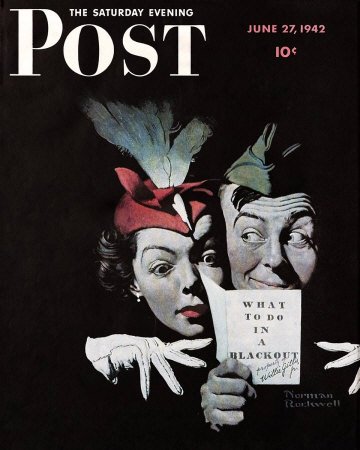 |
||||||||||||||
Norman Rockwell - Willie Gillis Blackout
June 27, 1942 Issue of The Saturday Evening PostThis painting by Norman Rockwell, Willie Gillis Blackout, appeared on the cover of The Saturday Evening Post published June 27, 1942. This is another timeless favorite of Rockwell collectors, a classic for the ages. This painting was Rockwell's fourth cover for The Post in 1942. In 1942, there were eight Norman Rockwell Saturday Evening Post covers published. This painting was also Rockwell's 208th overall of 322 total pictures featured on the cover of The Post. Rockwell's career with the Post spanned 47 years, from his first cover illustration, Boy With Baby Carriage in 1916 to his last, Portrait of John F. Kennedy, in 1963. This is also the fifth in Norman Rockwell's Willie Gillis series of covers for The Saturday Evening Post. Rockwell painted eleven images that appeared on the Post cover and one illustration that was featured inside the Post. The October 4, 1941 issue featured the first Willie Gillis cover. I have seen pristine original copies of this magazine cover sell for over one hundred dollars on eBay. And to think it only cost ten cents originally! And it was mint condition at that time, too. The whereabouts of the original oil on canvas painting is currently unknown. This painting also appears in three Rockwell commentary books. It appears:
Willie Gillis BlackoutGiclee Prints on Archival Paper: This classic Norman Rockwell painting shows Willie Gillis and a pretty, yet unnamed young lady in the dark caught in a blackout. When we think of blackouts nowadays, we tend to think of the power going out. That was not the prevailing thought in 1942. Blackouts were employed during World War Two to make it difficult for enemy bombers to see their intended targets at night. Blackouts were used in Great Britain so the setting for this painting probably takes place in the U.K. This is one of Rockwell's most successful art-deco type paintings. The brightness of the faces, their hands, their hats and the book in contrast with the blackout background is very striking. Let's talk about the pretty young lady. The model's name was Betty Timmins. The young lady is wearing a hat that was no doubt the height of fashion in the time the picture was painted. A red hat with a white feather sticking out would certainly get a GI's attention. She is reading Willie's book very intently. The expression on her face seems to convey almost an innocent quality. She seems to be concentrating on the pamphlet more than on her companion. The lovely Betty Timmins' daughter was kind enough to give extra details about her mother in an email. Please see below for that page. Now, let's consider our American soldier, Norman Rockwell's Willie Gillis. The model Rockwell used for all of the Willie Gillis paintings was Robert "Bob" Buck. He was not an American serviceman when Rockwell started the series. He enlisted to become a Naval aviator before the end of World War Two. In this painting, we can only see his face, hands and hat. Rockwell liked painting models with expressive faces. It looks like he hit the jackpot in this painting, especially with Willie. Willie Gillis Blackout was only one of 322 Norman Rockwell Saturday Evening Post covers; Here is the list of Norman Rockwell Saturday Evening Post cover illustrations.
Here is the complete list of all Norman Rockwell magazine covers. Willie is looking at his female companion out the corner of his eye. His brow is furrowed and he is sporting a sly grin. The copy of "What To Do In A Blackout" is Willie's own copy. He has probably studied it before and knows its contents. He is waiting for his companion to catch up. Then it will be time to practice what the booklet recommends. Dare we speculate how the couple will while away their time during the blackout?
(Image Only) Copyright © 1942 Saturday Evening Post & Curtis Publishing Company You may be also interested in these:
Remember to check back often.
|
Norman Rockwell Quotes:I'll never have enough time to paint all the pictures I'd like to. No man with a conscience can just bat out illustrations. He's got to put all his talent and feeling into them! Some people have been kind enough to call me a fine artist. I've always called myself an illustrator. I'm not sure what the difference is. All I know is that whatever type of work I do, I try to give it my very best. Art has been my life. Right from the beginning, I always strived to capture everything I saw as completely as possible. The secret to so many artists living so long is that every painting is a new adventure. So, you see, they're always looking ahead to something new and exciting. The secret is not to look back. I can take a lot of pats on the back. I love it when I get admiring letters from people. And, of course, I'd love it if the critics would notice me, too. You must first spend some time getting your model to relax. Then you'll get a natural expression. More at BrainyQuote. Rockwell Favorites
|
|||||||||||||
|
|
||||||||||||||
|
Images are copyrighted by their respective copyright holders. Graphic Files Protected by Digimarc. Contact us for details about using our articles on your website. The only requirements are an acknowledgement and a link.
|
||||||||||||||
















